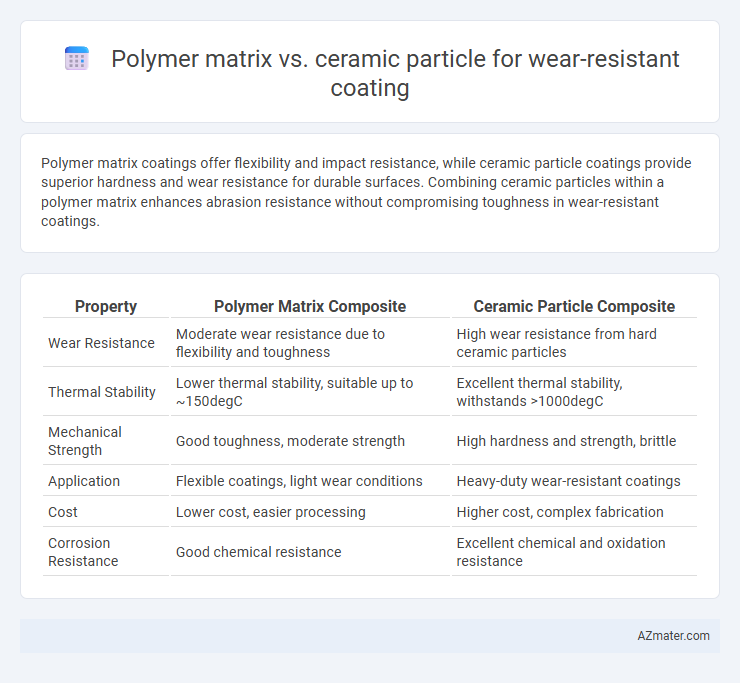Polymer matrix coatings offer flexibility and impact resistance, while ceramic particle coatings provide superior hardness and wear resistance for durable surfaces. Combining ceramic particles within a polymer matrix enhances abrasion resistance without compromising toughness in wear-resistant coatings.
Table of Comparison
| Property | Polymer Matrix Composite | Ceramic Particle Composite |
|---|---|---|
| Wear Resistance | Moderate wear resistance due to flexibility and toughness | High wear resistance from hard ceramic particles |
| Thermal Stability | Lower thermal stability, suitable up to ~150degC | Excellent thermal stability, withstands >1000degC |
| Mechanical Strength | Good toughness, moderate strength | High hardness and strength, brittle |
| Application | Flexible coatings, light wear conditions | Heavy-duty wear-resistant coatings |
| Cost | Lower cost, easier processing | Higher cost, complex fabrication |
| Corrosion Resistance | Good chemical resistance | Excellent chemical and oxidation resistance |
Introduction to Wear-resistant Coatings
Wear-resistant coatings enhance surface durability by minimizing material loss due to friction, abrasion, and impact. Polymer matrix coatings offer flexibility and corrosion resistance, making them suitable for low to moderate wear conditions, while ceramic particle-based coatings provide superior hardness and thermal stability for high-wear environments. Selecting the appropriate coating depends on application-specific demands such as operating temperature, load, and exposure to chemicals.
Overview of Polymer Matrix Coatings
Polymer matrix coatings consist of a polymer binder embedded with reinforcing particles, offering excellent flexibility and impact resistance for wear-resistant applications. These coatings provide effective abrasion protection by absorbing mechanical stresses and minimizing crack propagation compared to ceramic particle coatings, which are typically more brittle but harder. The versatility in polymer chemistry allows tailoring properties such as toughness, adhesion, and chemical resistance to suit diverse industrial environments.
Overview of Ceramic Particle Coatings
Ceramic particle coatings offer exceptional wear resistance due to their high hardness, thermal stability, and chemical inertness, making them ideal for protecting surfaces in harsh environments. These coatings typically consist of materials such as alumina, zirconia, or silicon carbide embedded in a matrix or applied as pure ceramic layers to enhance abrasion and corrosion resistance. The microstructure and particle size distribution of ceramic coatings critically influence their mechanical properties and long-term durability in wear-intensive applications.
Key Material Properties Comparison
Polymer matrix composites offer flexibility, impact resistance, and ease of processing, while ceramic particles provide high hardness, thermal stability, and excellent wear resistance. The polymer matrix's lower modulus and toughness contrast with the ceramic particles' superior hardness and brittleness, making ceramic-reinforced coatings preferable for abrasive environments. Optimal wear-resistant coatings often balance the ductility of polymers with the hardness of ceramics to enhance durability and lifespan.
Mechanical Performance and Wear Resistance
Polymer matrix composites offer enhanced flexibility and impact resistance but generally exhibit lower hardness and wear resistance compared to ceramic particle-reinforced coatings. Ceramic particles, such as alumina or silicon carbide, significantly improve mechanical strength, hardness, and abrasion resistance, making them ideal for high-wear applications. The superior wear resistance of ceramic particle coatings results from their ability to withstand high mechanical loads and resist micro-cutting and erosion, outperforming polymer matrices in durability and lifespan.
Thermal Stability and Environmental Durability
Polymer matrix coatings exhibit moderate thermal stability, typically withstanding temperatures up to 250degC, whereas ceramic particle coatings maintain structural integrity at temperatures exceeding 1000degC, making them superior for high-temperature applications. Ceramic particles offer enhanced environmental durability due to their resistance to oxidation, chemical corrosion, and UV degradation, outperforming polymer matrices which can degrade under harsh environmental conditions. The integration of ceramic particles into a polymer matrix can improve wear resistance while balancing thermal stability and environmental durability for specialized coating applications.
Adhesion and Coating Integrity
Polymer matrix coatings exhibit superior adhesion to various substrates due to their inherent flexibility and ability to form strong interfacial bonds, enhancing overall coating integrity under mechanical stress. Ceramic particle coatings offer exceptional hardness and wear resistance but often suffer from weaker adhesion, resulting in potential delamination during high-impact or thermal cycling conditions. Optimizing the balance between polymer matrix ductility and ceramic particle reinforcement is critical for maintaining durable adhesion and sustained coating performance in wear-resistant applications.
Application Methods and Processing Techniques
Polymer matrix wear-resistant coatings typically utilize spray coating, dip coating, or brush application, followed by curing processes such as thermal or UV curing to achieve adhesion and durability. Ceramic particle coatings, often applied via plasma spraying, flame spraying, or electrophoretic deposition, require high-temperature sintering or heat treatment to bond particles firmly to the substrate and enhance wear resistance. The choice of polymer matrix coatings favors flexibility and ease of application, whereas ceramic particle coatings demand precise thermal processing for superior hardness and abrasion resistance.
Cost Analysis and Scalability
Polymer matrix composites generally offer lower material and processing costs compared to ceramic particle composites, making them more economically viable for large-scale wear-resistant coating applications. Ceramics provide superior hardness and thermal stability but require high-temperature processing and specialized equipment, significantly increasing production costs and limiting scalability. Industrial scalability favors polymer matrix systems due to their ease of application, lower energy consumption, and compatibility with existing manufacturing technologies.
Future Trends in Wear-resistant Coating Technologies
Future trends in wear-resistant coating technologies emphasize the integration of polymer matrix composites combined with ceramic particles to enhance durability and performance under extreme conditions. Research highlights the development of nano-structured ceramic reinforcements within polymer matrices, resulting in coatings with superior hardness, thermal stability, and resistance to abrasion. Advancements in deposition techniques and material engineering aim to optimize adhesion and reduce brittleness, paving the way for longer-lasting, lightweight wear-resistant surfaces in industrial and automotive applications.

Infographic: Polymer matrix vs Ceramic particle for Wear-resistant coating
 azmater.com
azmater.com